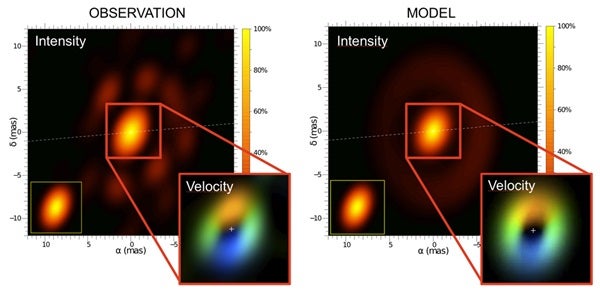HD 62623 is an exotic, hot supergiant star. Contrary to its well-known twin, the bright star Deneb in the Summer Triangle, and almost all stars with the same spectral class, this star is surrounded by a dense and complex environment composed of plasma and dust. Hot supergiant stars are so bright that they push their strong wind with their own photons. Such a wind would normally prevent matter from condensing as dust next to the star. To better understand dust formation processes in the harsh environment of such stars, it is highly desirable to disentangle the geometry of the gas and dust in the surroundings of the central source, but also to access the kinematics of this close environment.
“Thanks to our interferometric observations with Amber, we could synthesize a 3-D image of HD 62623 as seen through a virtual 130- meter diameter telescope,” said Millour. “The resolution is an order of magnitude higher compared with the world’s largest optical telescopes of 8- to 10-meter diameter.” The Amber instrument is located at the Very Large Telescope Interferometer (VLTI) in Chile. The scientists significantly improved the image quality by adapting the so-called “self-calibration” method, which is well-known from radio interferometry. The obtained image combines spatial and velocity information, showing not only the shape of the close environment of HD 62623, but also its kinematics or motion. Up to now, the necessary kinematics information was missing in such images.
“Our new 3-D image locates the dust-forming region around HD 62623 very precisely, and it provides evidence for the rotation of the gas around the central star,” said Anthony Meilland. “This rotation is found to be Keplerian, the same way the solar system planets rotate around the Sun.” A nearby companion star, with approximately the mass of our Sun, could be the reason of such a disk around HD 62623. This companion, though not directly detected due to its brightness thousands of times lower than the primary star, is betrayed by a central cavity between the gas disk and the central star. The presence of the companion could explain the exotic characteristics of HD 62623, exactly like the monster among the old stars within our galaxy, Eta Carinae.
The new 3-D imaging technique presented in this work is equivalent to integral-field spectroscopy, but gives access to a 15 times better angular resolution or capacity to detect fine details in the images. “With these new capacities, the VLTI will be able to provide a better comprehension of many sky targets, too small to be resolved by the largest telescopes,” said Millour. “We could aim at young stellar disks or jets, or even the central regions of active galaxies.”
HD 62623 is an exotic, hot supergiant star. Contrary to its well-known twin, the bright star Deneb in the Summer Triangle, and almost all stars with the same spectral class, this star is surrounded by a dense and complex environment composed of plasma and dust. Hot supergiant stars are so bright that they push their strong wind with their own photons. Such a wind would normally prevent matter from condensing as dust next to the star. To better understand dust formation processes in the harsh environment of such stars, it is highly desirable to disentangle the geometry of the gas and dust in the surroundings of the central source, but also to access the kinematics of this close environment.
“Thanks to our interferometric observations with Amber, we could synthesize a 3-D image of HD 62623 as seen through a virtual 130- meter diameter telescope,” said Millour. “The resolution is an order of magnitude higher compared with the world’s largest optical telescopes of 8- to 10-meter diameter.” The Amber instrument is located at the Very Large Telescope Interferometer (VLTI) in Chile. The scientists significantly improved the image quality by adapting the so-called “self-calibration” method, which is well-known from radio interferometry. The obtained image combines spatial and velocity information, showing not only the shape of the close environment of HD 62623, but also its kinematics or motion. Up to now, the necessary kinematics information was missing in such images.
“Our new 3-D image locates the dust-forming region around HD 62623 very precisely, and it provides evidence for the rotation of the gas around the central star,” said Anthony Meilland. “This rotation is found to be Keplerian, the same way the solar system planets rotate around the Sun.” A nearby companion star, with approximately the mass of our Sun, could be the reason of such a disk around HD 62623. This companion, though not directly detected due to its brightness thousands of times lower than the primary star, is betrayed by a central cavity between the gas disk and the central star. The presence of the companion could explain the exotic characteristics of HD 62623, exactly like the monster among the old stars within our galaxy, Eta Carinae.
The new 3-D imaging technique presented in this work is equivalent to integral-field spectroscopy, but gives access to a 15 times better angular resolution or capacity to detect fine details in the images. “With these new capacities, the VLTI will be able to provide a better comprehension of many sky targets, too small to be resolved by the largest telescopes,” said Millour. “We could aim at young stellar disks or jets, or even the central regions of active galaxies.”










